Depth of Seeding
Seeding depth can have a significant impact on plant development, refer to Figure 1, Days to emergence at various seeding depths, but soil conditions at the time of planting must always dictate seeding depth. Do not plant shallow into dry soil in anticipation of rain for germination. Plant into moisture to ensure quick and uniform emergence, even if it requires planting deeper. However, when soil conditions are too wet, consider shallow planting or making an additional tillage pass in an attempt to dry the soil.
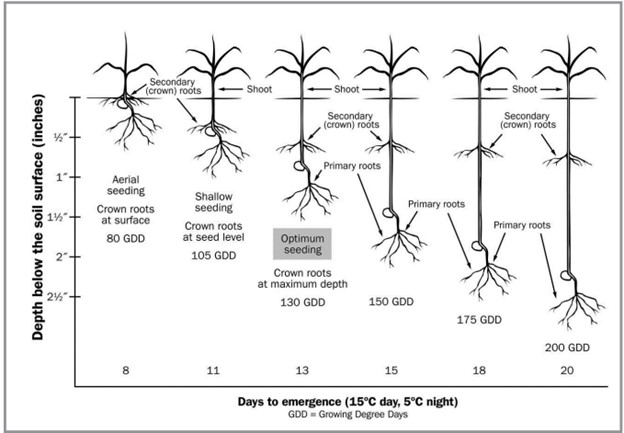
Figure 1. Days to emergence at various seeding depths
Cereals are lagging far behind corn and soybeans in the development and adoption of technology to accurately control seeding depth. With current drills, seed depth can vary from 1.25–7.5 cm (0.5–3 in.) in the same row, depending on soil conditions.
Producers can attempt to minimize this variation in depth by using seed firmers, which hold the seed at the bottom of the trench. Level fields and slower planting speeds will help reduce variability. Seeding depth accuracy in cereals will not match corn as long as depth gauge wheels (press wheels) trail double disc openers, or single coulters without parallel linkage are standard equipment.
Cereals are the most responsive crops to early, timely seeding, see Planting Dates, page XX. When cereals are seeded too deep, delayed emergence of 1 week or more may occur, see Figure 4–1. Delayed emergence is equivalent to an equal delay in seeding date, resulting in an equal reduction in yield. It is evident that the accuracy of seeding equipment requires improvement.

Optimum Seeding Depth[LR1]
Cereals should be planted uniformly at a depth of 2.5 cm (1 in.). This encourages early emergence and rapid development of an extensive secondary root system. Moisture availability is an overriding factor, and seed must be placed into moisture. A 2.5 cm (1 in.) planting depth is of little value if moisture is not available at this depth.
While seed depth of 2.5 cm (1 in.) is optimum, most drills are not capable of that level of accuracy. The yield penalty from too shallow is almost always greater than the yield penalty from a deeper planting depth. When drill accuracy is factored in, the target seeding depth should range from 3–4 cm (1.25–1.5 in.). Producers that do an accurate job of seeding winter wheat will experience better winter survival and higher yields.
Cereal Development
The development of the cereal seedling can be determined by following growing degree day (GDD) accumulations. GDD calculations are discussed in greater detail in Growing Degree Days, Chapter 10, Scouting. For cereal crops, use GDD base 0 calculations.
Generally, cereals require 80 GDDs for the seed to germinate and 50 additional GDDs for emergence, for each inch of planting depth.
Figure 4–2, Cereal growth stages, shows detailed cereal crop development according to the Zadoks Scale. (Feekes is another cereal development scale, often used in the USA, but not shown here.) These stages are critical in many management decisions that producers make. Nitrogen and herbicide applications must be completed during the tillering stage; while disease control is most critical in the stem extension and heading stage. Knowing the growth stage of the crop is essential to accurately schedule management inputs and control measures.
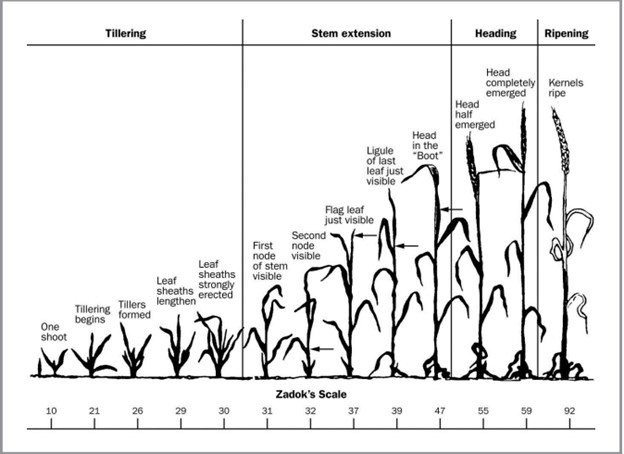
Figure 4-2. Cereal growth stages
For more detailed information and identification of cereal growth stages, refer to the Cereal Staging Guide at www.bayercropscience.ca (under Resources and Guides).
Planting Dates
Cereal crops are more responsive to planting date than corn. Ontario research shows a 0.07 t/ha/day (1.1 bu/acre/day) decrease in yield for each day that cereal planting is delayed beyond the optimum date.
Provincial winter wheat yields from 1981 to 2014 are illustrated in Figure 4–3, Provincial winter wheat yield for 1981–2014. The record yield in 2006 was primarily due to early planting the previous fall, while low yields in 1993 were the result of late seeding in the fall of 1992. The low yield of 1996 was caused by a severe fusarium (FHB) infection.
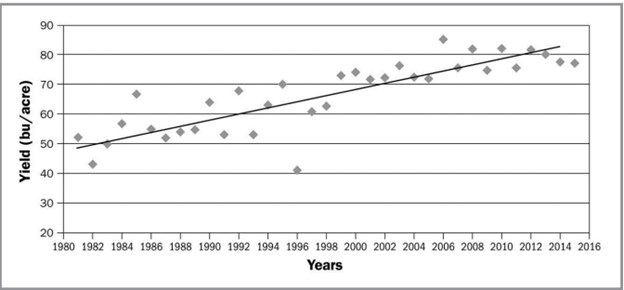
Figure 4-3. Provincial winter wheat yield for 1981-2014
Early Planting
Winter cereals can be seeded too early. Seeding more than 10 days before the optimum date introduces risk from Hessian fly, snow mould, and barley yellow dwarf virus (BYDV) infection. While Hessian fly is often cited as a concern, there has not been an infestation of significance in Ontario since at least 1985, thus it should not limit early seeding. BYDV is spread by aphids, which feed on wheat seedlings. Seed-applied insecticides can minimize the risk of spread of BYDV but will not eliminate the risk. Check varietal response to BYDV in the performance trials at www.gocereals.ca. Aphids are very susceptible to low temperatures. Aphid numbers and related concerns drop off as cool fall temperatures arrive. For more information on Hessian fly, cereal aphids or BYDV, see Chapter 13, Insects and Pests of Field Crops and Chapter 14, Diseases of Field Crops.
While seeding of winter cereals can be too early, the risk of not planting in a timely fashion carries far greater yield risk for producers on heavy, poorly drained clay soils. In these situations, plant if the soil conditions are fit. When seeding more than 10 days prior to the optimum date, decrease the seeding rate by 25%. Using lower seeding rates in this situation reduces the risk of snow mould and lodging. Yields often increase with lower seeding rates at these early planting dates.
As winter barley must be seeded early, select a variety with tolerance to BYDV, or utilize seed-applied insecticides that control aphids. See Publication 812, Field Crop Protection Guide.
Spring Cereals
It is virtually impossible to seed spring cereals too early unless soil conditions are excessively wet. This tremendous response to early seeding is convincing some producers to consider frost seeding. Cool, moist spring conditions promote tillering and production of large heads. The flowering dates of the crop are also advanced, avoiding the hot, dry conditions that often exist in late June and July.
The target date for planting spring cereals is April 10th for southwestern Ontario, April 15th for central and eastern Ontario and May 10th for northern Ontario. In areas of greater than 3,100 CHUs, spring cereals are generally not recommended and should definitely not be grown if planting is delayed beyond April 20. Check with Agricorp for latest seeding dates to be eligible for production insurance.
Winter Cereals
The seeding date for winter wheat is often determined by the date soybeans are harvested. This can delay optimal planting dates for winter wheat, resulting in reduced yields. Wheat grown after soybeans is easily facilitated by following the simple guidelines outlined in, Winter Wheat Following Soybeans, Chapter 2, Soybeans.
Figure 4–4, Optimum date to seed winter wheat across Ontario, shows the ideal seeding dates for winter wheat. The isolines on the map are based on average weather conditions from 1981 to 2017; actual results will vary from year to year. Seed winter barley 7–10 days prior to the optimum dates for winter wheat to improve winter survival. Winter barley has less winter hardiness than winter wheat.
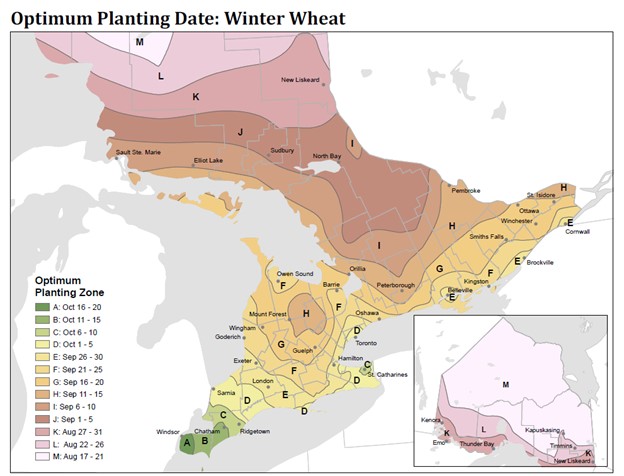
Figure 4-4. Optimum date to seed winter wheat across Ontario
Replanting
Winter cereals are one of the few crops that provide a second opportunity to assess the crop in spring and replant to another crop if winter survival was not acceptable. Assess the wheat crop during April and early May and leave the replant decision as late as possible to accurately determine plant stand and plant health.
Damaged plants will often recover under good weather conditions, while plants that are expected to recover may die if hot dry conditions exist. Table 4–6, Determining yield potential for various plant stand counts, indicates yield potential for various plant stand counts. The planting date will have an impact on the replant decision.
Table 4-6. Determining yield potential for various plant stand counts
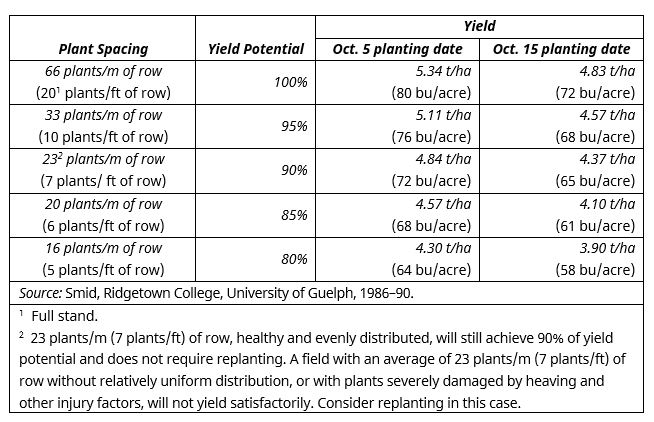
Seeding Rates
Historically, the seeding rates of cereal crops were recommended in bu/acre, with 2 bu/acre (135 kg/ha) a standard that covered most cereal crops.
Blanket statements of this nature are no longer acceptable. Seed size affects seeding rate. Set optimum seeding rates for each cereal crop. Table 4–7, Guidelines for cereal crop plant populations gives the ideal seeding rates for each crop. Table 4–8, Determining seeding rate indicates the seeds per metre of row and kilograms of seed per hectare required to achieve various desired plant populations.

Sample Seeding Rate Calculation
Seeds/kg (seeds/lb) should be stated on the seed tag or bag. For instance, if 3.7 million seeds/ha (1.5 million seeds/acre) is desired, with a germination rate of 95% and 26,500 seeds/kg (12,000 seeds/lb), the seeding rate would be 147 kg/ha (132 lb/acre).
Metric = 3,700,000 x 100 = 147 kg/ha
26,500 95
Imperial = 1,500,000 x 100 = 132 lb/acre
12,000 95
Table 4-7. Guidelines for cereal crop plant populations
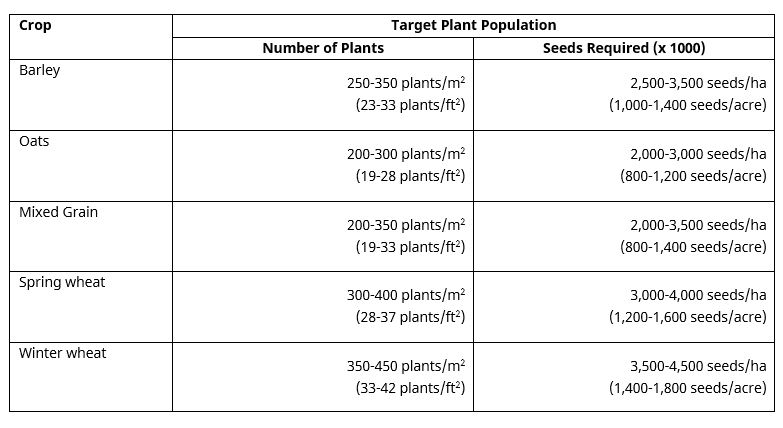
Use the higher rates in Table 4–7 and Table 4–8:
- where emergence and early seedling establishment are likely to be poor (for example, due to poor seedbed and aerial or broadcast seedings)
- for late planting where tillering will be reduced
- on very heavy clay soils
Table 4-8. Calculating seeding rate by row width to achieve target plant density
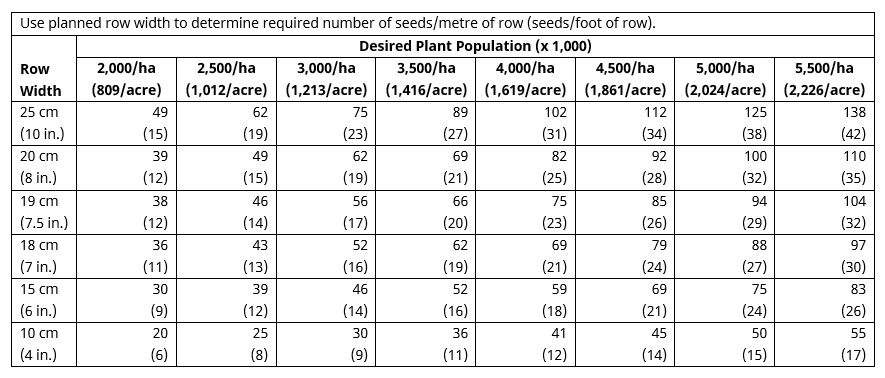
Table 4-9. Calculating seeding rate by row width to achieve target plant density
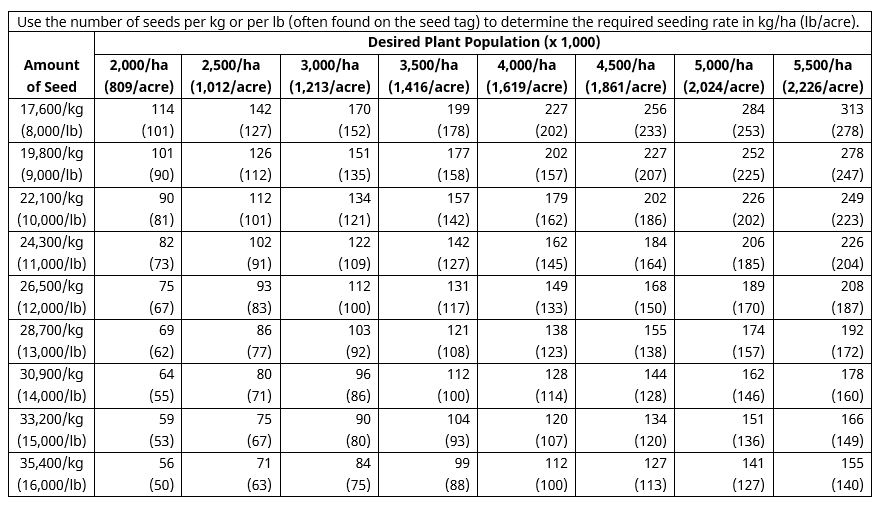
Row Widths
Considerable research has been conducted on cereal row widths for maximum yield. A summary of some winter wheat row width research from across Ontario and the northern U.S and from Ontario on-farm results concludes that there is no evidence to support narrowing row widths below the standard 18–19 cm (7–7.5 in.) spacing for winter crops.
There appears to be a yield penalty with wider rows. The most recent Ontario row-width research shows an 8% decrease in yield when moving to 38 cm (15 in.) rows from 19 cm (7.5 in.). In some cases, this yield loss may be offset by reduced equipment costs and result in more profit if less equipment investment is required. 25 cm (10 in.) row corn/soybean planters have more accurate seed placement than 19 cm (7.5 in.) drills. With the importance of seeding depth, this improved accuracy may partially overcome the row width impact, as indicated by Essex, Middlesex and Ohio data, where accurate planting equipment was used for the 25 cm (10 in.) row widths.
For spring cereal crops, trials in northern Ontario have shown yield increases of more than 5% when row width was reduced from 18–10 cm (7–4 in.) spacing. Moving to 10 cm (4 in.) rows in this production area may prove beneficial. However, it is difficult to achieve these narrow row widths in a no-till system.
Crop Rotation for Winter Wheat
Crop rotation is an integral part of any production system. The greatest benefit to a good crop rotation is increased yields. A well-planned crop rotation will help with insect and disease control and aid in maintaining or improving soil structure and organic matter levels. In addition to increasing yields, using a variety of crops can reduce weed pressures, spread the workload, protect against soil erosion and reduce risk. Table 4–10, Management considerations for wheat following various crops in rotation, shows some of the risks associated with, and management options for, wheat following other crops.
Table 4-10. Management considerations for wheat following various crops in rotation
| Following: | Comments |
| Processing peas | ● best rotation ● best option for early planting ● residual nitrogen results in lower N requirement for wheat ● lodging may be an issue |
| Edible beans | ● excellent rotation ● timely planting often possible ● higher yielding than wheat after soybeans |
| Soybean | ● excellent rotation ● when soybean harvest is delayed, wheat planted later will have lower yield ● potential on sandy soils, European chafer populations can reduce plant stands |
| Canola | ● excellent rotation ● timely planting possible ● response to starter P may be greater (Canola is non-mycorrhizal) |
| Corn (silage or grain) | ● highest risk of fusarium ● timely planting is possible (silage) ● for wheat after corn, plant a variety that is MR for fusarium (see www.gocereals.ca) and plan to apply a fungicide to prevent fusarium |
| Alfalfa (pure stands) | ● timely planting is possible ● insect damage is a concern ● nitrogen credit is not fully utilized because of timing of N release relative to crop requirements. Up to half the N is released after crop uptake is complete |
| Grass hay | ● poor rotation ● primary risk is take-all, a root disease that infects the crop in the fall with a potential yield loss of over 50%, and other root diseases ● later planting combined with seed-placed potash fertilizer provides some take-all suppression |
| Oats | ● reasonable rotation ● timely planting possible ● few diseases cross over between wheat and oat |
| Barley | ● fair rotation ● timely planting possible ● root diseases cross over between barley and wheat ● later planting combined with seed-placed potash fertilizer provides some take-all suppression. |
| Wheat | ● worst choice since not a rotation ● leaf disease and root disease pressure will be at its maximum ● take-all, eyespot and cephalosporium stripe are at high risk with little or no management options ● expect a minimum 10% yield loss |